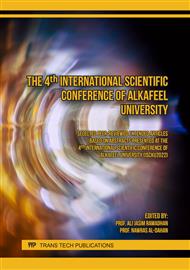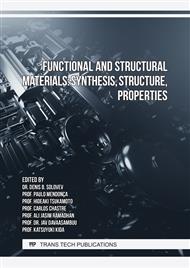[1]
Dessimoz, A.-L., Intensification of gas/liquid chemical synthesis using microreactors and new operating windows. 2011, EPFL.
Google Scholar
[2]
Stankiewicz, A. and J.A. Moulijn, Process intensification. Industrial & Engineering Chemistry Research, 2002. 41(8): pp.1920-1924.
DOI: 10.1021/ie011025p
Google Scholar
[3]
Hessel, V., Novel process windows–gate to maximizing process intensification via flow chemistry. Chemical Engineering & Technology: Industrial Chemistry‐Plant Equipment‐Process Engineering‐Biotechnology, 2009. 32(11): pp.1655-1681.
DOI: 10.1002/ceat.200900474
Google Scholar
[4]
Potyrailo, R., et al., Combinatorial and high-throughput screening of materials libraries: review of state of the art. ACS combinatorial science, 2011. 13(6): pp.579-633.
DOI: 10.1021/co200007w
Google Scholar
[5]
Ehrfeld, W.,V. Hessel, and V. Haverkamp, Microreactors. Ullmann's encyclopedia of industrial chemistry, 2000.
DOI: 10.1002/14356007.b16_b37
Google Scholar
[6]
Hessel, V., et al., Micro Process Engineering, 3 Volume Set: A Comprehensive Handbook. Vol. 1. 2009: John Wiley & Sons.
Google Scholar
[7]
Osouli-Bostanabad, K., et al., Microfluidic manufacture of lipid-based nanomedicines. Pharmaceutics, 2022. 14(9): p.1940.
DOI: 10.3390/pharmaceutics14091940
Google Scholar
[8]
Hamad, K. I., Humadi, J. I., Issa, Y. S., Gheni, S. A., Ahmed, M. A., & Hassan, A. A. (2022). Enhancement of activity and lifetime of nano-iron oxide catalyst for environmentally friendly catalytic phenol oxidation process. Cleaner Engineering and Technology, 11, 100570.
DOI: 10.1016/j.clet.2022.100570
Google Scholar
[9]
Humadi, J.I., Issa, Y. S., Aqar, D. Y., Ahmed, M. A., Alak, H. H. A., & Mujtaba, I. M. (2022). Evaluation the performance of the tin (IV) oxide (SnO2) in the removal of sulfur compounds via oxidative-extractive desulfurization process for production an eco-friendly fuel. International Journal of Chemical Reactor Engineering.
DOI: 10.1515/ijcre-2022-0046
Google Scholar
[10]
Charpentier, J.-C., In the frame of globalization and sustainability, process intensification, a path to the future of chemical and process engineering (molecules into money). Chemical Engineering Journal, 2007. 134(1-3): pp.84-92.
DOI: 10.1016/j.cej.2007.03.084
Google Scholar
[11]
Humadi, J. I., Gheni, S. A., Ahmed, S. M., & Harvey, A. (2022). Dimensionless evaluation and kinetics of rapid and ultradeep desulfurization of diesel fuel in an oscillatory baffled reactor. RSC Advances, 12(23), 14385-14396.
DOI: 10.1039/d2ra01663j
Google Scholar
[12]
Tu, S.-T., et al., Development of micro chemical, biological and thermal systems in China: A review. Chemical Engineering Journal, 2010. 163(3): pp.165-179.
Google Scholar
[13]
Humadi, J. I., Gheni, S. A., Ahmed, S. M., Abdullah, G. H., Phan, A. N., & Harvey, A. P. (2021). Fast, non-extractive, and ultradeep desulfurization of diesel in an oscillatory baffled reactor. Process Safety and Environmental Protection, 152, 178-187.
DOI: 10.1016/j.psep.2021.05.028
Google Scholar
[14]
Hamberg, A., et al., High‐throughput synthesis and analysis of acylated cyanohydrins. Chemistry–A European Journal, 2007. 13(15): pp.4334-4341.
DOI: 10.1002/chem.200601638
Google Scholar
[15]
Jovanovic, G.N., et al., Dechlorination of p-chlorophenol in a microreactor with bimetallic Pd/Fe catalyst. Industrial & engineering chemistry research, 2005. 44(14): pp.5099-5106.
DOI: 10.1021/ie049496+
Google Scholar
[16]
Kim, S., et al., Continuous preparation of itraconazole nanoparticles using droplet-based microreactor. Chemical Engineering Journal, 2020. 393: p.124721.
DOI: 10.1016/j.cej.2020.124721
Google Scholar
[17]
Wani, I.A., et al., Silver nanoparticles: ultrasonic wave assisted synthesis, optical characterization and surface area studies. Materials Letters, 2011. 65(3): pp.520-522.
DOI: 10.1016/j.matlet.2010.11.003
Google Scholar
[18]
Abou El-Nour, K.M., et al., Synthesis and applications of silver nanoparticles. Arabian journal of chemistry, 2010. 3(3): pp.135-140.
DOI: 10.1016/j.arabjc.2010.04.008
Google Scholar
[19]
Beyene, H.D., et al., Synthesis paradigm and applications of silver nanoparticles (AgNPs), a review. Sustainable materials and technologies, 2017. 13: pp.18-23.
DOI: 10.1016/j.susmat.2017.08.001
Google Scholar
[20]
Jain, A.S., et al., Bionanofactories for green synthesis of silver nanoparticles: Toward antimicrobial applications. International Journal of Molecular Sciences, 2021. 22(21): p.11993.
DOI: 10.3390/ijms222111993
Google Scholar
[21]
Tehri, N., et al., Biosynthesis, antimicrobial spectra and applications of silver nanoparticles: Current progress and future prospects. Inorganic and Nano-Metal Chemistry, 2022. 52(1): pp.1-19.
DOI: 10.1080/24701556.2020.1862212
Google Scholar
[22]
Amini, E. and M. Azadfallah, In situ synthesis of silver nanoparticles on fiber matrix for preparing antibacterial paper. Biointerface research in applied chemistry, 2018. 8(4): pp.3449-3456.
Google Scholar
[23]
Ghahremanloo, A. and M. Movahedzadeh, The effect of silver nano particles on Candida albicans and Streptococcus mutans in denture acrylic resins. Journal of Dental Materials and Techniques, 2016. 5(1): pp.23-30.
Google Scholar



